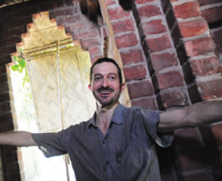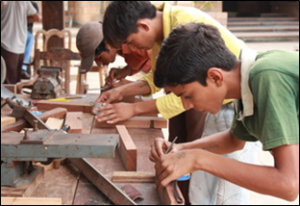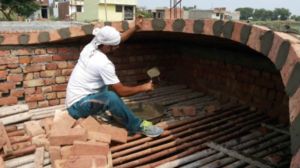 Partha Pratim Mitra is an Ex-Chief Economic Adviser, Ministry of Rural Development and Principal Labour and Employment Adviser, Ministry of Labour and Employment, Government of India. With rich experience in the socio-economic issues and policies concerning the rural development, labour and employment sectors, he has held many significant positions and contributed immensely in the said fileds.
Partha Pratim Mitra is an Ex-Chief Economic Adviser, Ministry of Rural Development and Principal Labour and Employment Adviser, Ministry of Labour and Employment, Government of India. With rich experience in the socio-economic issues and policies concerning the rural development, labour and employment sectors, he has held many significant positions and contributed immensely in the said fileds.
In an interview for Open Interview, Mitra speaks to Saradindu Bhaduri regarding grassroots innovations, skills development in masonry, documentation and dissemination of informal practices through the major Government programmes. Mitra is of the view that there is a need to break popular myths by changing mindsets and to disseminate the documented information on frugal innovations. It is important that certain common mindset issues prevalent in society are dispelled forthwith to bring in alternate thinking.
:
First of all, thank you for agreeing to have this conversation with us.
Thank you. It’s a pleasure.
We, at the Centre for Studies in Science Policy, Jawaharlal Nehru University (JNU), are interested in innovation dynamics in the informal economy, where innovations are intricately linked to one’s skill and ‘on the job’ experience. We are curious to know your thoughts on how such innovations can be integrated into these flagship programmes of the Government of India.
Of course! I would love to share my thoughts.
If Skill India or Digital India can be used to document and spread such innovations, which often remains ‘below the radar’ of the conventional discourse on innovation and development?
Let me begin by giving a general introduction about these programmes. Digital India and Skill India are the two flagship programmes of the central government which focus on technology and employability.
The Skill India programme gives priority to standardisation of qualification and certification of skill training courses through accredited institutions where sectorial skill councils play an important role. The Skill India programme has a reasonable blueprint but there are issues at the implementation level which need to be looked into. Particularly- issues such as certification by assessors and how to raise awareness among grassroot beneficiaries need to be addressed. In the Skill India programme, Recognition of Prior Learning (RPL) is an important component which intends to certify the prior learning of skilled artisans.
For Digital India, let me restrict my focus only to its relevance in relation to the Skill India Programme and its beneficiaries.
An entire new paradigm was attempted to be brought about through the digital platform, which to an extent, has been successful in the financial sphere through the Jan Dhan accounts (JDA) and public transfer of funds through the Public Financial Management System (PFMS) between the centre and the recipients at the state level. Rough estimates put about 38 crore JDA accounts as a tool of direct benefit transfer, which could be put to good use in these pandemic times. Estimates also indicate that there are about 9 crore mobile users making communication technology reach the citizens. However, connectivity is an issue in the remote locations which needs much improvement.
Could you please share some specific examples to showcase the way Skill India functions ?
Let’s take the case of masonry. It is an important component of the RPL programme. A skilled mason is expected to get a skill training certificate based on a field demonstration of his skills and the assessor would certify his/her skills present at the field demonstration site.
This example of masonry is indeed an important one. In India, we have multiple types of housing structures, ranging from traditional mud houses to the ones with concrete roofs and a great variation in each of these categories. Today, we hear a lot about the need for affordable housing, sustainable housing, etc. Do you think the knowledge and the experiences of masons could prove to be useful in fulfilling these aspirations?
That’s a good question. Of course, I do see a lot of potential in using the skills and expertise of masons in this regard. However, we must also admit that building is a non-green operation in its core. There can only be ‘green actions’ or ‘sustainable actions’, where the owner’s lifestyle and the skills of the builder are in harmony with the environment. For example: there is Laurent Fournier who lives with bare minimum in Kolkata, India. One should read about him. [Please refer Modern buildings cannot breathe]
 Fournier is emphatic that under no circumstance will he get an air conditioner (AC). He wants to minimise his family’s energy consumption. He has also diligently collected monthly electricity bills for 10 other apartments in the same building for over a year, plotted them into energy graphs and found that average energy consumption in an apartment with one AC is more than five times that of an apartment without one. “Not only do ACs consume more electricity, households using them tend to be casual about the increase in energy bills.” Source : Click Here
Fournier is emphatic that under no circumstance will he get an air conditioner (AC). He wants to minimise his family’s energy consumption. He has also diligently collected monthly electricity bills for 10 other apartments in the same building for over a year, plotted them into energy graphs and found that average energy consumption in an apartment with one AC is more than five times that of an apartment without one. “Not only do ACs consume more electricity, households using them tend to be casual about the increase in energy bills.” Source : Click Here
While talking about mud housing, we have to admit that there is a basic problem about buildings with mud. Who will build your mud house? If you have the time and inclination, it is not a great problem maybe in rural areas, and in the outskirts of small towns, but it can be quite a problem for really urban areas (and in Development Authority areas you may have difficulty in obtaining permission to build). It is worth mentioning that people will tell you that it is not possible to build mud houses in a city because there is no mud to use, in the first place. However, such people have to be reminded that neither is there burnt brick or cement nor steel, if you can bring in these things, you can bring in mud too.
This is encouraging to know. But I think it would be very natural for a reader to compare mud houses with cement houses. Could you please explain the technology and knowledge component of mud houses in this context?
Indeed. As we might all have seen, traditional buildings use diverse raw materials for its construction, and quite often focus on using materials which are available locally. I would say binders and stabilizers are the two very important aspects of mud house buildings, and where the knowledge, and experience of masons play an important role in choosing the right binder and stabiliser which would be sustainable too. Just for understanding, the most common stabilizer we use in modern housing is cement. It is costly and uses excessive energy in its manufacture, right? In comparison, most of the older indigenous stabilisers are natural local waste products, which are costless, or almost so, and most importantly, almost no energy has been expended, except of course manpower.
To begin with, these houses use many different forms of stabilisers to ensure that mud walls stabilise and remain strong to support the roof. There is a list of common, well-tried ones, for instance, straw. In clay soils the straw seems to minimize cracking, and in blocks the presence of straw tends to make the damp blocks more handleable. Similar to straw, people in different areas use chaff (bhusa) and various fibres. Cow-Dung often contains a lot of fibrous material and traditionally is often used in all sorts of mud work. Urine is also used. Probably this is because of the urea content and the urea acts as a ‘binder’ – a sort of glue. Gum Arabic and other gums and resins are used, also as binders and water proofing agents. Sugar and molasses are used. The crude waste jaggery is a binder too, and it often contains fibrous materials, which is also useful. Tannic acid and its wastes, used in other rural industries have often proved to be a good stabiliser. Oil has also found its uses.
In Kerala, for example, coconut oil was used, mainly with the intention of water proofing the surface of mud walls. Almost any oil is useful in this way and the modern counterpart is waste engine oil or sump oil. This works well as a waterproofing in cement concrete as well as in mud walling. However, we must not forget that the most common and effective stabiliser is Soil itself. If your soil is too sandy then clay is the best stabiliser for it. If it is too clayey, sand is the best stabiliser for it. In fact, in many parts of India the soils, or mixture of soils as you find them, are satisfactory and can be used without stabilisers. Only experimenting and testing will show you whether you need a stabiliser or not.
I think if you really want to appreciate the importance of mud then you must look at the works of Lawrence Wilfred “Laurie” Baker. He was very fond of mud and worked a lot with this material. [Please refer http://eartharchitecture.org/uploads/mud_english.pdf]
 Lawrence Wilfred “Laurie” Baker (March 2, 1917 – April 1, 2007) was an award-winning English architect, renowned for his initiatives in low-cost housing by using traditional techniques, materials and crafts such as mud and thatch. He came to India in 1945 in part as a missionary and since then lived and worked in India for over 50 years. He obtained Indian citizenship in 1989 and resided in Thiruvananthapuram (Trivandrum), Kerala. In 1990, the Government of India awarded him with the Padma Shri, the nation’s fourth highest civilian award, in recognition of his meritorious service in the field of architecture. Source: https://eartharchitecture.org/?p=364
Lawrence Wilfred “Laurie” Baker (March 2, 1917 – April 1, 2007) was an award-winning English architect, renowned for his initiatives in low-cost housing by using traditional techniques, materials and crafts such as mud and thatch. He came to India in 1945 in part as a missionary and since then lived and worked in India for over 50 years. He obtained Indian citizenship in 1989 and resided in Thiruvananthapuram (Trivandrum), Kerala. In 1990, the Government of India awarded him with the Padma Shri, the nation’s fourth highest civilian award, in recognition of his meritorious service in the field of architecture. Source: https://eartharchitecture.org/?p=364
That’s indeed a fantastic account of not only the technical details, but also the diversity in the use of raw materials across the length and breadth of this country. You have also given a very interesting perspective of what is ‘local’. In your view, the ‘local’ may be a by-product, or the waste material of the modern industry located nearby. So, in that way, it does not really confine itself to the binary of ‘traditional’ versus ‘modern’ but combine them as and when necessary? Am I right?
That’s correct.
You also give us a rich account of the diversity in practices. What do you think is the role of masons in cultivating, and sustaining these diversity?
I would say they are the backbone of these activities. It’s their trial and error, and the so-called ‘trick of the trade’ which enriches these activities, and keeps these alive. We need to encourage such innovations keeping in mind the regional diversities and local resources.
Who else are involved in this process? Do you see much role of the scientific community, researchers or civil society organisations in developing these alternative forms of technologies in India?
It may be difficult to exactly pinpoint the actual players in the examples which I have given but certainly the role of artisans, civil society organisations and enlightened architects and technical persons are all important as a complete ecosystem to encourage what may be called frugal innovations in this area. One very pertinent example could be the Hunnarshala Foundation, a grassroot organisation based at Bhuj, Gujarat. This organization is concerned with the huge surge of building activities in the country that is almost entirely using energy intensive industrialized materials like cement and steel and on the other hand seeing the rapid decline of artisanship and use of sustainable materials like stone, earth, thatch, bamboo, etc.
How do such knowledge or skills get diffused? I can imagine the organisation like the one you mentioned may have their own mechanism to train people. But, generally, for people practicing outside such organisations, as is the case in the informal economy, what is the system available to train people in these systems?
Let me answer this question in two parts. First, I will try to explain how the organisation keeps this practice alive, before turning to the more complex, but exciting case of training and diffusion of such practices in the informal economy in general.
The organisation I mentioned above has initiated a very interesting education initiative as well as an entrepreneurship incubation cell called Karigarshala or artisan school where dropouts from the formal education system aged between 16 to 18 are inducted for training in carpentry and masonry. At the end of their yearlong training, the organisation helps them find work as artisans, who otherwise in the absence of such training would be relegated to being unskilled migrant labor.
Now, coming to the second part of the question, about training and diffusion in the informal economy. Well, first let me confess that this is a minefield of new research for students interested in the field for the sheer diversity it offers. Broadly speaking, however, the system that is more common is the different variants of the so-called ‘Ustad-Chela’ relationship, what we call apprenticeship in the modern parlance. [Please refer http://www.hunnarshala.org/artisan-school.html]
 Hunnarshala’s concern has been witnessing the huge surge of building activity in the country that is almost entirely using energy intensive industrialized materials like cement and steel and on the other hand seeing the rapid decline of artisanship and use of sustainable materials like stone, earth, thatch, bamboo, etc. One of our permanent projects is an education initiative as well as an entrepreneurship incubation cell. We run a Karigarshala or artisan school where we train dropouts from the formal education system aged between 16 to 18 in carpentry and masonry. At the end of their yearlong training, we help them find work as artisans. In the absence of such training, they would be relegated to being unskilled migrant labor.
Hunnarshala’s concern has been witnessing the huge surge of building activity in the country that is almost entirely using energy intensive industrialized materials like cement and steel and on the other hand seeing the rapid decline of artisanship and use of sustainable materials like stone, earth, thatch, bamboo, etc. One of our permanent projects is an education initiative as well as an entrepreneurship incubation cell. We run a Karigarshala or artisan school where we train dropouts from the formal education system aged between 16 to 18 in carpentry and masonry. At the end of their yearlong training, we help them find work as artisans. In the absence of such training, they would be relegated to being unskilled migrant labor.
Let me illustrate with the example of a technique widely prevalent in the northern part of the country. It’s called shallow domes technique. You can refer to an article I read on architecturelive.in for one really very interesting reference point for those interested in architecture. [Please refer https://architecturelive.in/the-shallow-maso]. So this oldest shallow dome found in western Uttar Pradesh and Haryana is around 400 years old, built in lakhauri bricks with lime mortar. The rise of the dome varies from 9 inches to 2 feet. A team from Hunnarshala evaluated these techniques during the rehabilitation of the riots affected people of Muzzaffar Nagar. The tradition of building these domes is passed through the ‘Ustaad-Chela’ (Master Student) system.
Shallow dome without the formwork
The chela learns about the technique with the master and only when the master thinks that the chela is ready, he can individually construct the dome. Once the student starts constructing the domes, he further experiments with the technique to develop his own signature style. The technique has gone through several changes through the time, as new materials like cement and steel gained recognition, which impacted the aspirations of the people. The general aspirations tilted towards having roofs. The artisans were able to reduce the rise by using tiles and also reduce the thickness of the wall by using a ring beam.
There is fascinating diversity in these practices too. There are two types of shallow masonry domes, which are presently built in western U.P. and Haryana, dish type and tray type. Two distinct methods, one with shuttering and one without shuttering are used to build these domes. In the villages of Uttar Pradesh, the masons use shuttering methods for building the domes and produce variations in the dome using the same. Nawab, an artisan from the same region makes dish type domes and pours concrete in the joints whereas Salim, another artisan makes tray type domes with rich cement mortar. Maumin, another artisan, on the other hand makes both dish and tray type domes using rich cement mortar. The domes rest on walls built in mud mortar and are supported on a ring beam with a 12 mm dia bar. In Haryana, the artisan’s building method differs. Narayan, a mason in Kalyani, District Nadia (West Bengal), and his family make dish type shallow domes without shuttering with rich cement mortar. The ring beam supports it, which is an L beam with six 12mm dia bars. The dome also rests on walls built in cement mortar and the artisans refrain from building mud mortar walls unless they are at least 2 feet thick.
I hope I have been able to give some idea about the practices, and hope you understand why I said at the very outset that this is a minefield for research. So much is there around us, and so little we know about them.
Indeed. I hope this interview will motivate some students to take up these issues for their research. I would like to get back to the questions with which we started the interaction. How do you think the flagship programmes, Skill India and Digital India can be of help in stimulating, and spreading such practices and innovations?
Yes, I must say that skill development has to be grounded in the societal needs and aspirations. Skill development will never happen in isolation. Frugal innovations are one way of grounding such skill formation and training in the society and the courses or certification will be through institutions which encourage skill formation through frugal innovations like the Hunnarshala artisan school in Bhuj. Simultaneously, the programmes may also be useful to help generate awareness about the need and usefulness of such frugal innovations. We must break the fixed mindsets of people towards certain popular myths which come in the way of wide scale diffusion of such frugal innovation and skill formation. So the purpose of the platform which I have proposed is two -fold, to break popular myths by changing mindsets and to disseminate the documented information on frugal innovations. It is important that certain common mindset issues prevalent in society are dispelled forthwith to bring in alternate thinking.
Mr. Mitra, this has been a very enriching experience for me, and I believe the students and researchers in the field of innovation studies and science policy would take note of the points you have highlighted. Thanks you very much for sharing your rich experience.
Thank you very much for the invitation to share my ideas. I look forward to seeing some exciting new research from your Centre in the coming years.
∞∞∞∞
Note · All the answers/ opinion expressed in this interview/document are of the interviewee.
Courtesy · Images used: downtoearth.org.in/; hunnarshala.org/; architecturelive.in/; in.pinterest.com; Cooperation: Anup Kumar Das, JNU
Cite · Bhaduri, Saradindu (2020 July, 8). Partha Pratim Mitra: Break popular myths and disseminate documented information on ‘frugal’ innovations. [Blog post]. Retrieved from: https://openinterview.org/2020/07/08/partha-pratim-mitra:-break-popular-myths-and-disseminate-documented-information-on-‘frugal’-innovations/
 Saradindu Bhaduri teaches at the Centre for Studies in Science Policy, at Jawaharlal Nehru University (JNU), New Delhi. Frugal innovation and innovation policy are the key area of his research. He has held Prince Claus Chair in Development and Equity at International Institute of Social Studies, (EUR), the Hague . He is currently associated with the LDE Centre for Frugal Innovation in Africa.
Saradindu Bhaduri teaches at the Centre for Studies in Science Policy, at Jawaharlal Nehru University (JNU), New Delhi. Frugal innovation and innovation policy are the key area of his research. He has held Prince Claus Chair in Development and Equity at International Institute of Social Studies, (EUR), the Hague . He is currently associated with the LDE Centre for Frugal Innovation in Africa.



Interview is very interesting as well as informative.